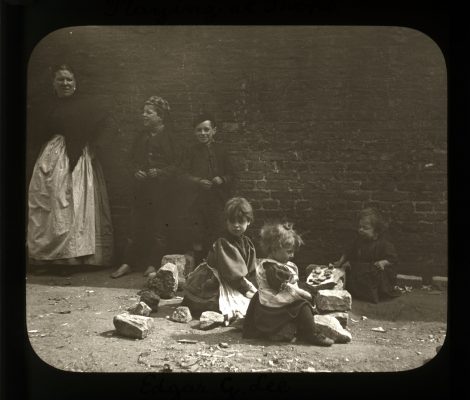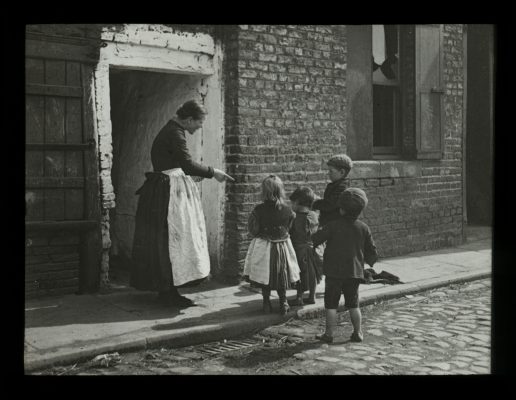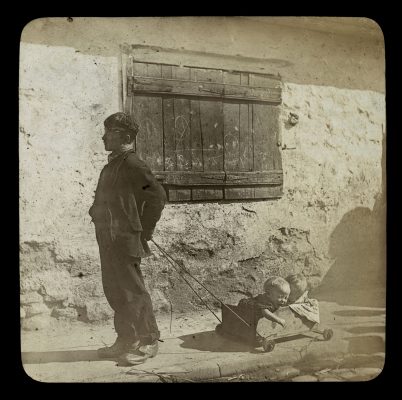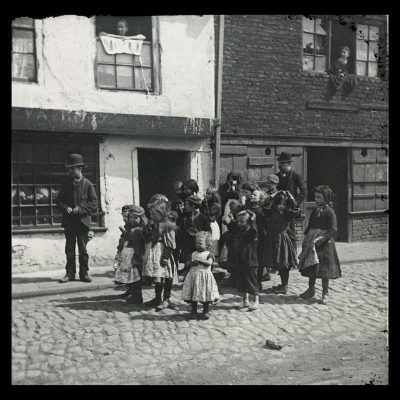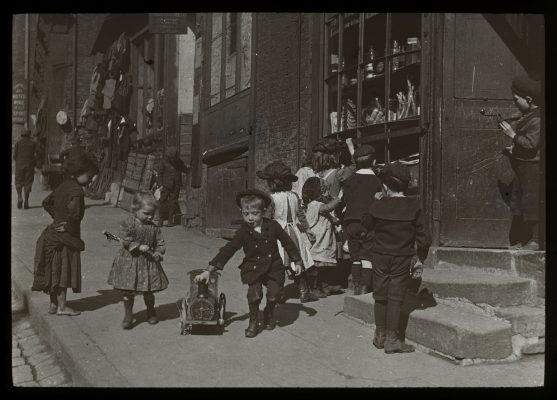Photographs of children on Newcastle’s streets, 1890s
Reference: SANT/PHO/SLI/35/6, 13, 21, 47, 49, 122
Suggested age groups: KS1, KS2, KS3, KS4, Lifelong Learners
Subject areas: History, Literacy, Art, Technology
CONTEXT
The photographer of these images, Edgar G. Lee, was born in Simonburn, near Hexham in 1860. Edgar made his living from taking portrait photographs of the upper and middle classes in Tyneside and Northumberland. He also took photographs on Newcastle’s Quayside which was one of the poorest areas in the country, at that time.
These six photographs are an example of about 300 that we hold at Northumberland Archives, taken by Edgar G. Lee. They show children playing on the streets of Newcastle in the 1890s. From the pictures you can see the clothes that they wore (some are not wearing shoes) and the things that they played with (rocks, toy train and piece of rope tied around a lamppost).
In front of the toy shop (SANT/PHO/SLI/35/49) there are two children who contrast rich (or well-off) and poor. The little boy at the centre of the picture is well-dressed (hat, coat with shiny buttons and boots) and is playing with a toy train. Looking on is a girl on the side of the pavement (left side of photo). She is wearing no hat or shoes, her hair looks uncombed and her legs look very dirty.
Fixing images using chemicals (photography) was invented and developed during the Victorian period. Henry Fox Talbot carried out a series of experiments at his home in Wiltshire during the 1830s and produced the first photographic negatives. He made his experiments public when he found that Louis Daguerre was doing similar experiments in France.
This new invention became very popular from the middle of the nineteenth century. Julia Margaret Cameron used photograph to make portraits of the people around her, including Charles Dickens and the poet Alfred Tennyson. Edward Muybridge used it to capture the movement of people and animals. His work led to the invention of moving pictures. (Please see links for further information about both photographers.)
ACTIVITIES
ACTIVITY 1
Background
The photographer of these images, Edgar G. Lee, was born in Simonburn, near Hexham in 1860. Edgar made his living from taking portrait photographs of the upper and middle classes in Tyneside and Northumberland. He also took photographs on Newcastle’s Quayside which was one of the poorest areas in the country, at that time.
SEE
See: Who took these photographs?
See: How did Edgar G. Lee make his living?
See: Where were these photographs taken?
See: Who is in the photographs?
See: Was Newcastle’s Quayside a rich or poor area at the time?
THINK
Think: Are the children all dressed the same in the photographs?
Think: Do the children in the photographs all look as though they are the same social class?
Think: How can you tell that some children are poorer than others?
Think: What types of toys are the children playing with? What do the toys tell you about the children’s backgrounds?
DO
Do: Using Google Maps, look up how Newcastle Quayside looks today. Do you think it is still a poor area?
Do: Think about children’s toys and games today. Make a list of the similarities and differences between how children today play and how Victorian children played.
Do: Choose one of the photographs, write a script of the scene taking place in the image.
Resources
ACTIVITY 2
Background
Fixing images using chemicals (photography) was invented and developed during the Victorian period. Henry Fox Talbot carried out a series of experiments at his home in Wiltshire during the 1830s and produced the first photographic negatives. He made his experiments public when he found that Louis Daguerre was doing similar experiments in France.
This new invention became very popular from the middle of the nineteenth century. Julia Margaret Cameron used photograph to make portraits of the people around her, including Charles Dickens and the poet Alfred Tennyson. Edward Muybridge used it to capture the movement of people and animals.
SEE
See: What colour are the photographs?
See: How clear are the photographs?
THINK
Think: How were photographs taken during the late nineteenth century?
Think: How were photographs developed during the late nineteenth century?
Think: Can photographs still be taken on film and developed using chemicals today?
Think: What type of camera do you think the photographs were taken using?
Think: How long would it have taken to take each photograph?
Think: Why might some parts of the photographs be blurry?
Think: How do these photographs compare to photographs we can take today? Make a list of some of the similarities and differences.
DO
Do: Using digital cameras, iPads, or a similar device with a camera, take photographs of the room you are in. Can you edit these photographs to look similar to Edgar’s photographs? How does changing the colour affect the photograph?
Do: What do you think someone in 100 years’ time could learn about the room from your photographs?
Do: Look at some examples of 1890s cameras such as the Folding Flat Kodak. Have a go at making a model of one of the cameras. Do you think it would have been easy to use and transport?
Do: Using photosensitive paper and the instructions from Sun Print, create your own chemical-free exposed image.
Do: Make a list of all of the processes that went into taking a photograph in the 1890s. Think about the equipment that was needed, the size and weight of the equipment, how the equipment had to be transported, how the equipment had to be set up, how long it may have taken to set up the equipment, how long it took to take the photograph and how long it took to develop the photograph.
Do: Make a list of all of the processes that go into taking a photograph today.
Do: Compare your list of processes. Create a presentation showing how much photography has advanced since the 1890s.
Resources
ACTIVITY 3
Background
Edgar G. Lee took photographs on Newcastle’s Quayside which was one of the poorest areas in the country, at that time. These six photographs show children playing on the streets of Newcastle in the 1890s.
SEE
See: Do the photographs look as though they are posed or candid (taken informally /without the subject’s knowledge)?
See: Do the children look as though they are aware the photographs were being taken?
THINK
Think: What genre do you think these photographs are?
Think: Why do you think Edgar took these photographs?
Think: What can you learn about Newcastle Quayside from these photographs?
Think: What is the difference between street photography and documentary photography? Which do you think these photographs are an example of?
Think: Do you think these photographs give an accurate representation of what life was like?
DO
Do: What makes an image a documentary photograph? Write down the qualities you think make a documentary photograph.
Do: What is street photography? Write down the qualities that make a street photography image.
Do: Should the documentary or street photographer take the photograph as they see the scene without being involved or should they involve themselves in the scene to ‘stage’ or ‘direct’ parts of the photograph? Does this change the meaning or legitimacy of the photograph? Debate this in groups.
Do: Is documentary or street photography ethical? Create a presentation showing the ethical issues that have been raised around documentary or street photography.
Do: Write an artist’s manifesto for documentary or street photographers.
Do: Have a go at creating your own documentary or street photographs.
Resources
https://www.britannica.com/technology/photography/Documentary-photography
https://www.jamesmaherphotography.com/street_photography/what-is-street-photography/
https://www.city-academy.com/news/documentary-photography-vs-street-photography/
https://www.royalacademy.org.uk/article/ten-game-changing-manifestos
OTHER ONLINE RESOURCES
Edgar G Lee
Northumberland Archives website, Treasures exhibition, page for Edgar G Lee: https://northumberlandarchives.com/exhibitions/treasures/1.html
AmberSide Gallery website, page with Edgar G Lee exhibition: https://www.amber-online.com/collection/lee-collection/
Photography
Science Museum website, page about history of photography: https://www.scienceandmediamuseum.org.uk/objects-and-stories/history-photography
British Library website, page about invention of photograph (Henry Fox Talbot): https://www.bl.uk/collection-items/invention-of-photography
Bodleian website, biography of Henry Fox Talbot: https://talbot.bodleian.ox.ac.uk/talbot/biography/
National Portrait Gallery website, page about Julia Margaret Cameron: https://www.npg.org.uk/whatson/exhibitions/2003/julia-margaret-cameron
Victoria and Albert Museum website, page for Julia Margaret Cameron: https://www.vam.ac.uk/collections/julia-margaret-cameron
Tate website, page for Eadweard Muybridge exhibition: https://www.tate.org.uk/whats-on/tate-britain/exhibition/eadweard-muybridge
Eadweard Muybridge website: https://www.eadweardmuybridge.co.uk/


